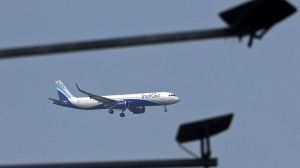Cops clueless on Nariman House,5 patrol boats were stuck in Worli
The report on the 26/11 Mumbai attacks,authored by Ram Pradhan,a former Governor and Union Home Secretary and V Balachandran...
The report on the 26/11 Mumbai attacks,authored by Ram Pradhan,a former Governor and Union Home Secretary and V Balachandran,a retired IPS officer,is said to have highlighted glaring lapses in the official response and the disturbing extent to which red-tape stalled the upgrade of the city police force.
The Indian Express has learnt that the Pradhan committee report makes startling revelations: how the top police brass did not know that Nariman House had Jewish residents until the attack; how Mumbais 56-member police Quick Reaction Team had done no firing practice since September 2007 for lack of ammunition; how five Cuffe Parade police patrol boats meant to be in the area where the 10 terrorists landed were away,tackling a protest in Worli against the Sea Link.
And how intelligence alerts were sifted first by a desk officer who hardly ever passed these to his seniors.
Its also learnt that the Pradhan committee backed the New York Police chiefs assessment that the Mumbai Police,in its current structure,would not have been able to respond and deal with attacks like the ones on 26/11 where the terrorists were far better trained,armed and equipped.
The committee is said to have praised the timely response of the Mumbai police but has also noted that it was as if the police were responding to a law order situation and not a terrorist attack.
Some glaring lapses the committee is said to have revealed:
Nariman House: Issaq Ibrahim Bagwan,ACP of the Azad Maidan division,was among the first to respond to explosions in the Colaba area. It is believed that the committee has found that no one had any idea of the significance of Nariman House.
The ACP apparently came to know about the Jewish residents only on reaching the spot.
Bagwan has also been praised for pinning down terrorists by organising fire from adjacent buildings until the NSG commandos arrived.
Incidentally,alerts on Jewish individuals being possible targets had gone from the Centre on several occasions.
Patrol Boats: There were five patrol boats,controlled by DCP (Port),which were to have been patrolling the area where the terrorists landed.
However,its now known that all these patrol boats were in the Worli area where the Machchimar agitation against the Worli Sea Link project had been under way since November 24,2008.
As a result,no patrol boats were present on the Cuffe Parade side.
In fact,sources said,the committee found that the DCP in-charge,Madhukar Kohe,learnt of the events from TV,hired a trawler and stationed himself in front of the Taj Hotel much later.
Desk Officer system: The committee is said to have found total confusion in the manner in which intelligence alerts are handled.
Senior bureaucrats dealing with internal security had not received any of the several alerts that had been marked from the Centre to the DGP,who had sent in ahead for action. Why?
Because the alerts went to a desk officer who may or may not keep the higher officials informed.
The committee is learnt to have pulled up the Secretariat in its report and called it a violation of the Bombay Police Act 1951. As a result,no top bureaucrat in Maharashtra Mantralaya was aware of these threats and so,consequently neither the political leadership.
Quick Reaction Teams: This 56-member force,which includes eight officers,was split into four or five smaller groups that apparently reduced its effectiveness.
The QRT is the best-equipped and trained unit in the Mumbai police to respond to such attacks. It was trained for three months under the NSG in 2003 when it was raised,but they are said to have told the committee that they received no hostage-rescue training at NSGs Manesar training facility.
More significantly,they have not had any firing practice since September 2007 because of shortage of practice ammunition.
Not just that,they had only 24 bullet-proof helmets for 56 personnel.
Flying Squads: Maharashtra had created 100 flying squads of motorcycle-borne commandos in teams of two each,of which 46 squads were meant for Mumbai 92 cops trained in martial arts and armed with more sophisticated weapons than the regular police.
The committee is said to have found that this system is now in disuse.
There are still 58 policemen set aside for the job but they played no role in the 26/11 operations.
Its learnt that the committees report lays bare numerous loopholes and significantly unmasks the fact that the modernization of the police force,though envisaged on paper,never took off.
As a result,on 26/11,the force reacted in a chaotic manner with several hotel employees confirming to inquiry officials that many policemen just entered with lathis in some cases,the antiquated .303 rifle.
(Tomorrow: who stalled modernisation and how)
- 01
- 02
- 03
- 04
- 05































